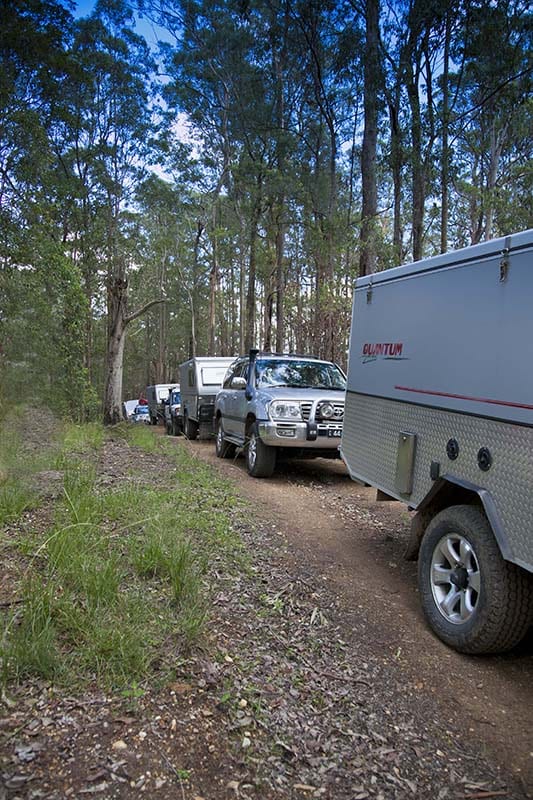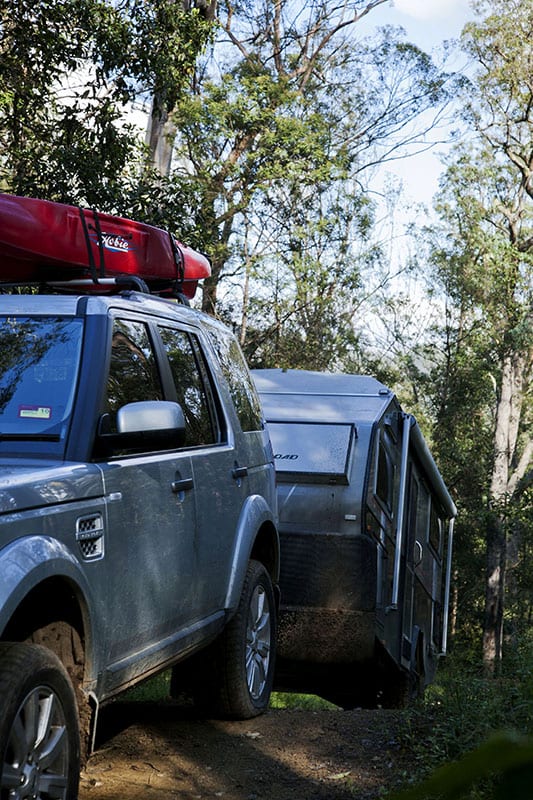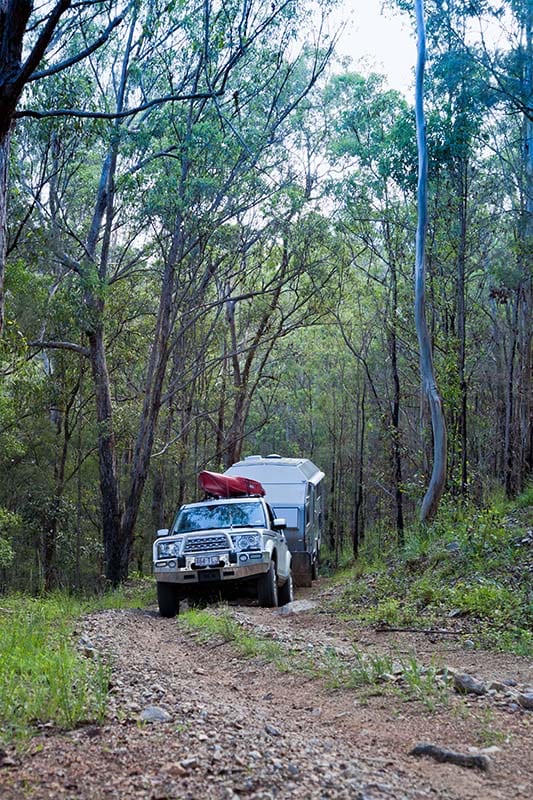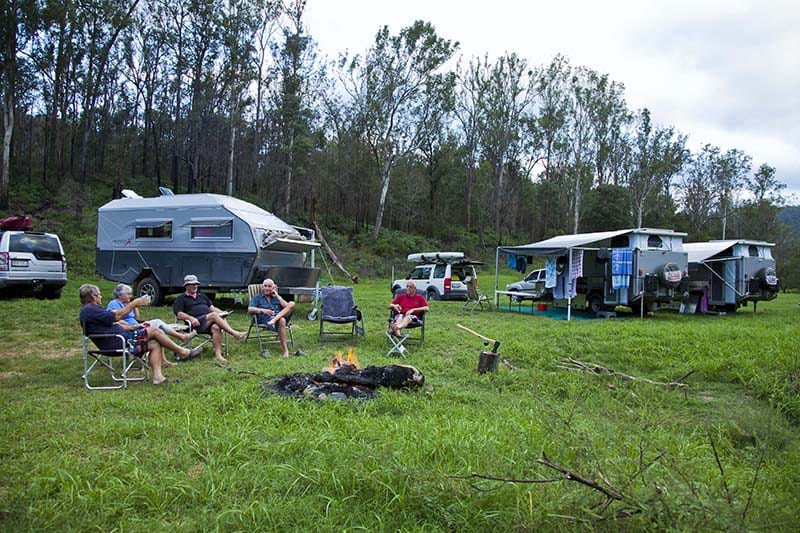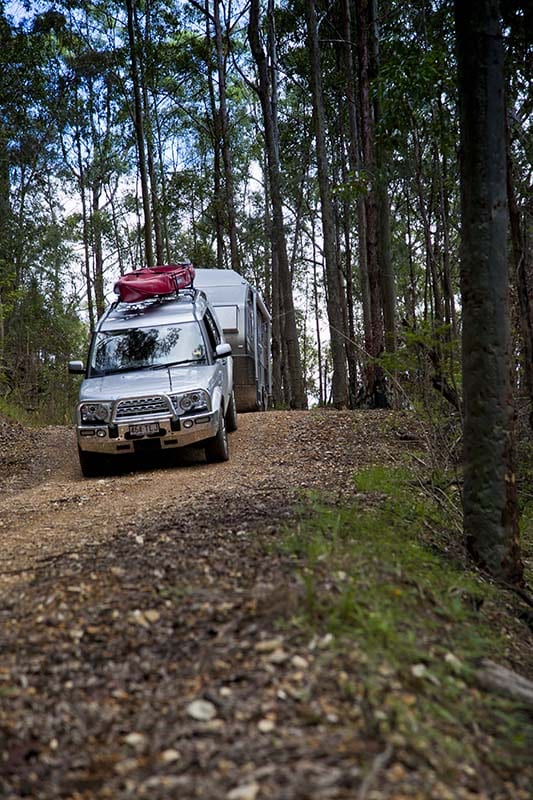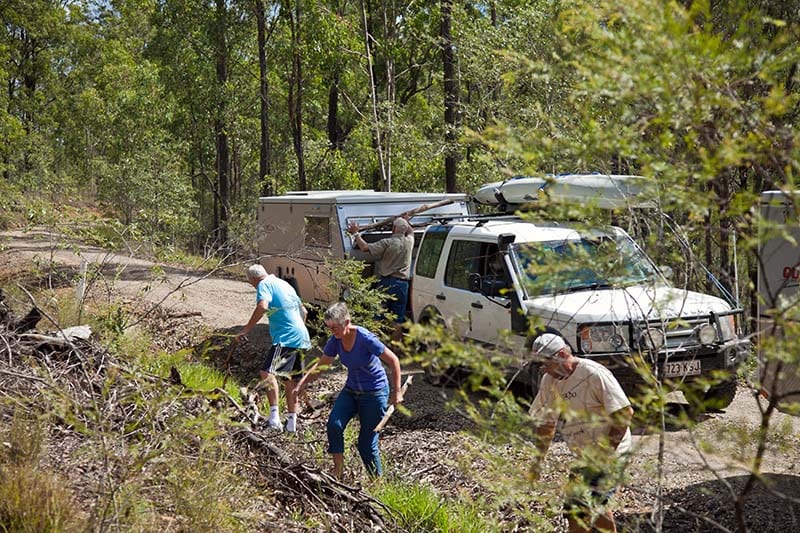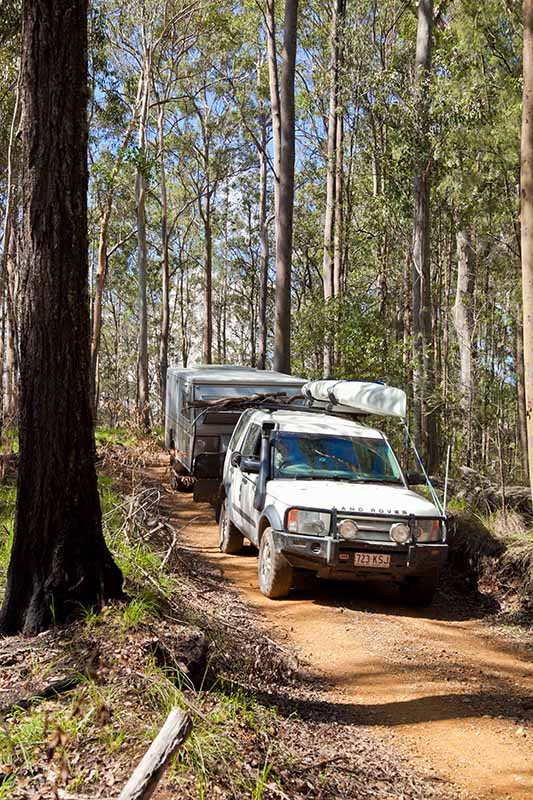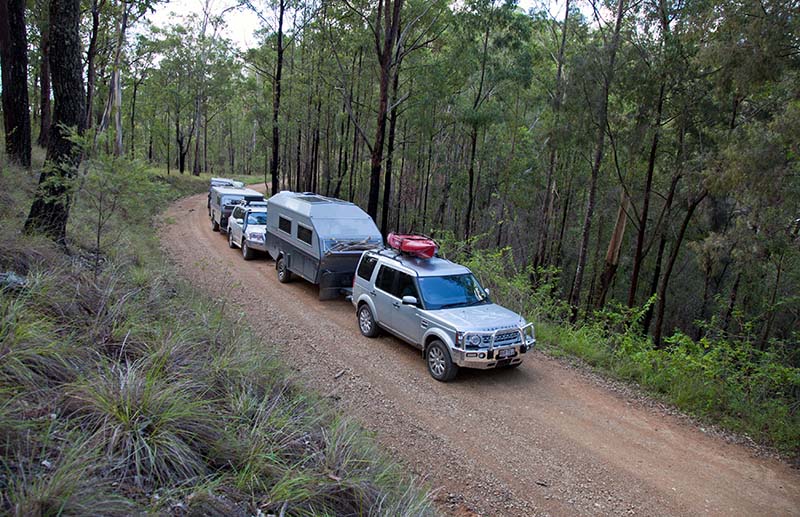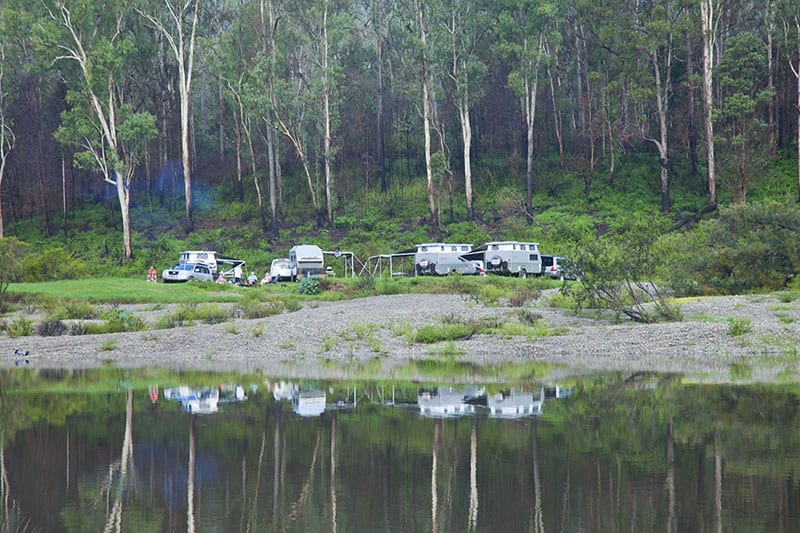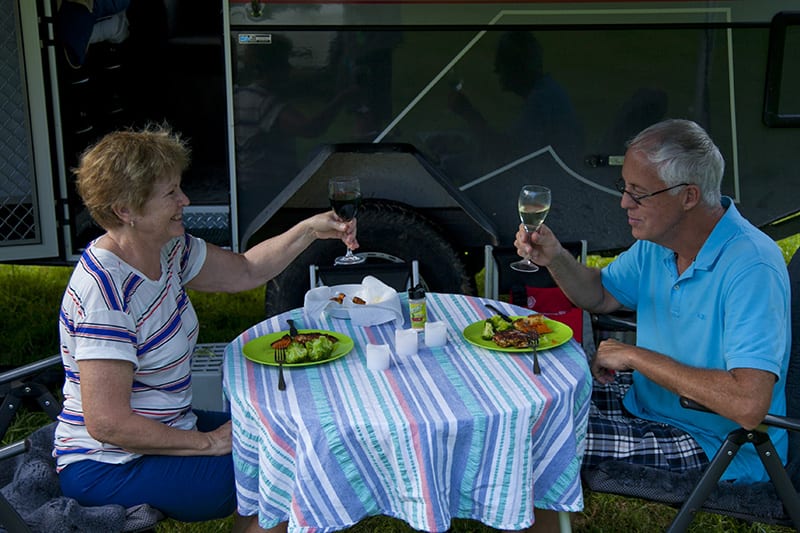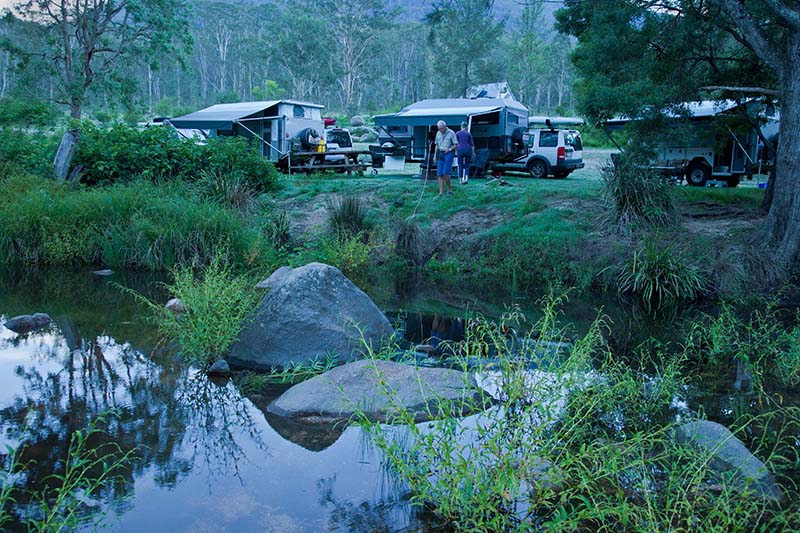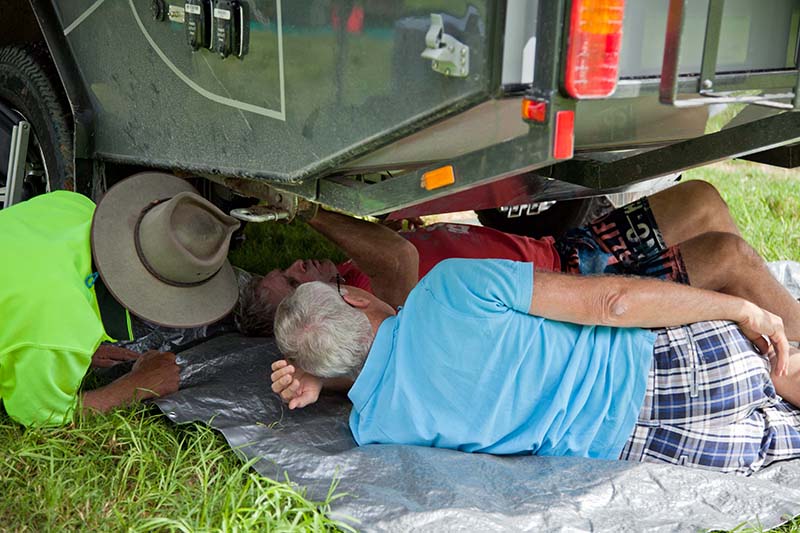It was reportedly the driest summer in 26 years until on the day prior to our planned departure mother nature unleashed a spectacular deluge of some 200mm. I considered launching the Hobie prematurely just to get around the back yard!
Camping in the luxury of a Matrix is an absolute delight but packing it in the torrential rain was……not to put too fine a point on it…..a pain.
Picture loading multiple boxes of gear while balancing an umbrella and a sudden rogue gust of wind taking said umbrella skywards! It was a case of $$#%^##………..I don’t want to play this game anymore.
Sulking in the rain wasn’t an option, neither was kicking the dog – and not only because we don’t own one; so I did the martyr thing and kept going. With Steve still at work and yet to pack all the bloke stuff an early morning start was not looking good. It’s at this stage after a busy working week that you begin to wonder whether it’s worth it but there was no thought of abandoning our trip with our limited time off being so hard won.
This was to be the first real outing for the Disco so there was a last minute rush to fit handy items like a brake-controller, UHF, kayak rack and cargo barrier. The Matrix was brand new – a Series III stocker from the showroom floor. Al arrived with Quantum in tow behind his 200 Series and we duly admired his new drawer set-up, the latest addition to his ever-increasing array of 4W drive kit.
Quite miraculously, and well ahead of predictions, some blue sky appeared and it was a leisurely first day jaunt to the peaceful Leslie Dam near Warwick.
Now it’s interesting when you’re camping with members of the AOR fraternity that an essential topic of conversation between the blokes is power – solar, that is. Morning, noon and night comparisons of power in, power usage and battery status take precedence over all ‘normal’ conversation and of course the discussions are stereotypical male in having to have a competitive edge.
It was in the course of such careful monitoring it became apparent there was power usage in the Matrix even with everything turned off. Ever the designer/investigator Steve just had to discover why. Every light and appliance was turned on and off individually and still there was current draw. Then everything at once, even the mains, and looking, looking by torchlight and still the gauge ticked over. More and more mysterious! (The hilarity of all this testing brought to mind the entertaining children’s story of Mr Archimedes’ bath read to my little ones many moons ago.) Ah ha found it! The tiny LED lights in the standby switches were, quite astoundingly, drawing 0.2 amps each. Note to self and to staff – source alternatives. There’s nothing quite like using the trailers ourselves as owners of AOR to discover first hand what works and what doesn’t.
The Mann River Nature Reserve had come highly recommended and this was to be our first camp. The Old Grafton-Glen Innes Road is accessed from the Gwydir Highway and although the steep descent to the Mann River was low range territory the track was fully sealed, making access relatively easy. Kaye and John were already set up in their Quantum – meeting us here after five weeks touring Victoria and (gratifyingly) adding another Land Rover to the mix. Although it had been cold and wet enough for them to kick up their diesel heater in Glen Innes, the days at Mann River were warm and sunny and it was the 12 volt Sirocco fans in both Quantums and Matrix that got a work-out.
The camp ground here is right on the banks of the picturesque Mann River, although at this point the river is just a series of water holes and not a venue to launch the kayaks. It is, however, a great base for exploration of an area that owns both breathtaking scenery and a romantic history of pioneers, gold miners and bushrangers. A day trip passes through spectacular river-lined farmland and the town of Dalmorton in the 1850s a gold mining centre that boasted a population of 5000 with 13 pubs. Now a ghost town, only some old buildings, cattle yards and a war memorial exist as reminders of its colourful past. Another point of interest is the old tunnel, hand-hewn through the rock. There is a delightful camping area right by the river at Dalmorton though to get there with a camper would involve careful negotiation of the areas where the track is narrow and littered with sharp fallen rocks.
As it happened our timing was perfect. The rain had clearly been wide-spread and the countryside looked like it had undergone an instant conversion from dishearteningly dry to an idyllic emerald green.
We were fortunate to see this spectacular area at its picture perfect best.
With Chris away on a girls jaunt to Melbourne Al had decided that, rather than doing the bachelor thing at home he would come along and do it camping, even if it meant foregoing the benefits of the local takeaway. He was determined to do it all himself and took to the challenge of having to cook with true gustatory gusto. The pinnacle of his achievement was a lamb roast with veges cooked to perfection in the Cobb!
Unfortunately, as is sometimes the case, the accessibility of this campsite meant putting up with those prime camping annoyances – generators and loud music. Why in all conscience do manufacturers of so called ‘off road’ caravans construct their vehicles without solar systems, forcing owners to have generators droning day and night? And why do some caravan owners assume the whole camp ground wants to listen to their particular style of music? OK, I’ll jump down off my soapbox now and move on – both literately and figuratively ………. to somewhere more remote.
Nymboida National Park was new territory for all of us and if it hadn’t been for Kaye’s research at National Parks in Glen Innes we’d probably still be looking for it. Their advice was that the last 6 kms to the river was only suitable for campers ………. mmmmm – do supercampers qualify ?…….and what about the Matrix? All an unknown quantity.
But nothing ventured, nothing gained and away we went. Now the overwhelming consensus among campers seems to be that the most essential element of the camping experience is a cozy camp fire. This meant that the first priority after turning off the Gwydir was to gather firewood before entering the national park. This is always lots of fun – clambering around in the bush finding the good bits – and the firewood racks on both Quantums and the Matrix were stacked with enough for our whole visit.
The track was well made and quite easy until we arrived at two gates – with no signs. One led to the left and one to the right. We guessed right, (as it turned out, correctly) and this is where things got really interesting! We were on top of a range and could see the sharp drop to the valley below. The steep descent started almost immediately, the track interspersed with deep culverts reminiscent of those in the Victorian High Country, testing the entry and exit angles of the trailers to the max. It was low range first gear territory especially with the trailers fully loaded and demanded significant 4W drive capability from both vehicles and drivers.
But the challenge of the track was quickly forgotten when we negotiated the last descent and surveyed all in front of us. It was the camping spot from heaven! Think a large field of thick green grass by a crystal clear river surrounded by misty mountains………and what’s more we had it all to ourselves! It seems the white water rafting that was the attraction here is no longer available because of limited water releases upstream.
There followed five days of the most idyllic camping imaginable. Peter and Jackie added another Quantum to the mix on the third day and the blokes in particular cooled off in the river regularly throughout each day. The Weber on the Matrix came in handy for producing luxuries like hot cinnamon muffins, enjoyed by all, as well as the always highly desirable roast dinners. John has his Hobie specifically set up for fishing, although the fish proved elusive, and our Hobie was great fun for finding different subjects to photograph or just cruising around.
There was only one problem. It was a problem it seems we all thought about but no one was articulating. With some good showers of rain persisting each night were we going to be able to get out again, or would we be stuck here indefinitely waiting for the track to dry out??? When finally the subject came up the decision was made to leave on the Friday rather than Saturday when significant rain was forecast. The added benefit would be the reduced likelihood of meeting weekenders coming down.
Having the Hobies was great for getting some images of our campsite from across the river. Steve readily relinquished his regular self-proclaimed role of ‘camera bitch’ in favour of some serious relaxation but John volunteered for the somewhat more elevated role of ‘photographic assistant’ and his first job was to reconnoiter a landing point.
We ventured out in both kayaks with camera gear in what is (hopefully) a waterproof compartment. Then came a climb up a hill through the scrub to find a good vantage point. Ah, the things we enthusiast photographers go through to get ‘the shot’! John’s brush with some surveying training came in handy for leveling the tripod on the steep slope. For the uninitiated panoramas involve taking a series of overlapping shots (in this case seven) and stitching them together in a program like Photoshop. The critical part is having tripod and camera completely level and there’s a bit of other techno stuff like knowing the nodal point of your lens for each focal length.
This idyllic river co-operated beautifully with the photographic enterprise by producing perfect early morning and late evening reflections in the soft light. The surrounding mountains also did their best with their rain-induced crowns of swirling mist. In all, it was an aspiring photographer’s paradise!!!
This kind of remote camping experience is what the AOR vehicles are designed to offer their owners. With lots of storage, huge solar capacity and bucket loads of water its possible to stay in pristine areas like Nymboida for extended periods. But the most significant point of difference is with the new toilet system. Where all other manufacturers choose to take the easy option and go with chemical toilets, AOR took the more innovative and far more expensive option of adapting a marine macerator system for their trailers. This system uses no chemicals whatever and has a 70L black storage tank that has up to a week’s capacity, representing extreme environmental integrity. There is simply no comparison between this system and its chemical alternative that has a two-day capacity at best and is unable to be disposed of ethically in a national park.
Well, all good things come to an end and after probably our most beautiful and relaxing camp ever it’s time to face, with some trepidation, getting back up the mountain. Tyre pressures were lowered even further and excess water dumped to lighten the load. As it turned out our fears were unfounded. The warm days had contributed to a drier track, the Discos and ‘Cruisers did what they do best and the Quantums and Matrix were towed up with ease.
We’ve now all decided that we have a version of the High Country (albeit just a taste) very much closer to home, a special place that’s become an all-time favourite.
RHONDA BUDDEN
With thanks to Al Stevenson, John Evans and Kaye Connor, and Peter and Jackie Bernas for all the fun around the campfire and your patient participation in the photographic process.
Notes on Power
With the decision to stay in our beautiful valley for as long as possible we faced the inevitable problem of the power consumption of the car fridges. As the solar on AOR products is very much an overpowered system there was plenty available to power the car fridge battery from the solar on the trailers. With 150 watts available powering the two large 120 amp batteries in the trailers and the car battery we were able to keep them all topped up by nightfall, even with the lower sun angles we encountered. Without this huge solar capacity we would have had to resort to a generator which we do not carry and, in any case, are generally not permitted in national parks.
Handy hint
Make a camping list and keep it on your computer. Make adjustments for each trip and print it off in a large font. That way if you’re packing after a busy working week and feeling brain dead you’re less likely to forget essential items.
We have one shelf in the shed and one in the pantry dedicated to camping items. This also makes it easier to pack, especially when you’re starting from scratch.

